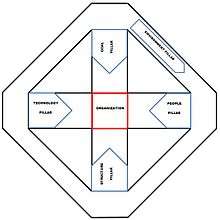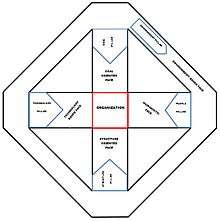The organization's face
The organization's face concept first time introduced in 2011 by Professor Mohammad Ali Sarlak in a multi-volume book entitled: The new faces of organizations in the 21st century.[1][2]
Definition of face
In Merriam Webster dictionary, face defines as a means of identification.[3] The face considered as people identification’s factor and a distinction means between individuals.
Definition of organization's face
The concept of organization’s face represents something that identifies and distinguishes the organization from other similar organizations.
The origins of organization's face
The concept of organization’s face is based on tow underlying metaphors:
The Organizations as living entity such as humans can be distinguished by face factor from each other.
What factors determine the organization's face?

The question is what are the factors that determine an organization’s face? To answer this question, Professor Sarlak uses the organization’s pillars model that is derived from the Lewitt model.[4] The pillars of an organization are shown in Figure 1.
Based on the organization's pillars model, the organization has at least five following pillars:
- People
- Goals
- Structure
- Technology
- Environment
Types of organization's face

As shown in Figure 2, with an emphasis on each of the organizational pillars, a specific type of organization’s face is formed.
Based on Figure 2, organizations can demonstrate five general face, simultaneously or separately:
- Humanistic face
- Goal oriented face
- Structure oriented face
- Technology based face
- Environment based face
Each of these faces is divided into more specific faces:
Humanistic face
The Ethical face of organizations
The Engaged employee face of organization
The Empathic face of organization
The Smart (emotional) face of organization
The Affective Face of Organizations
The Justice-Based Face of Organizations
The Trustworthy Face of Organizations
The Wise Face of Organizations
The Wisdom-Based Face of Organizations
The Virtuous Face of Organizations
The Value-Based Face of Organizations
Goal oriented face
The Strategy-Focused Face of SMEs
The Pluralistic face of organizations
The Hybrid Face of Organizations
New Innovative Face of Organizations
The Innovative Face of Public Organizations
The Learning Face of Organizations
The Knowledge Intensive Face of Organizations and Businesses
The Effective Face of Organizations
The Customer-Centric Face of Organizations
Structure oriented face
The Team-Based Face of Organizations
The Professional Adhocratic Face of Organizations
The Networked Face of Organizations
Technology based face
The ICT-Based Face of Public Organizations
The Virtual Face of Organizations
The Content-Based Face of Organizations
The Process-Based Face of Organizations
The Supply Chain Centric Face of Organizations
Environment based face
The Multicultural face of organizations
The Complex face of organizations
The Risk Managing Face of Organizations
The Outsource–Based Face of Organizations
The Pentatomic Face of Organizations
References
- ↑ Sarlak, Mohammad. A. (2011). The New Faces of Organizations in the 21st Century (Volumes:1,2,3). Canada: NAISIT Publishers.
- ↑ Sarlak, Mohammad. A. (2012). The New Faces of Organizations in the 21st Century (Volumes:4,5). Canada: NAISIT Publishers.
- ↑ http://www.merriam-webster.com/dictionary/face
- 1 2 Scott, W. Richard. (1998). Organizations: Rational, Natural, and Open Systems, 4th edn . Upper Saddle River, NJ: Prentice-Hall.
- ↑ Morgan, Gareth. (2006). Images of Organization. Newbury Park. CA: Sage Publications.